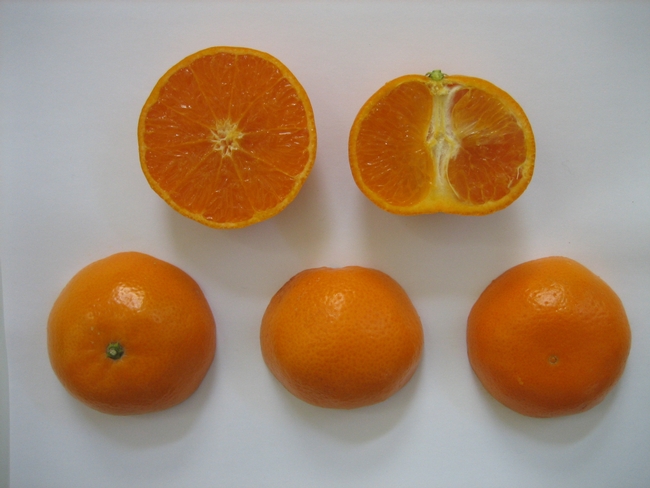It's a fruit...It's a mandarin...It's ‘KinnowLS’!
On the Jeopardy show, the clues could easily be: “It’s new and attractive. It’s juicy and sweet. And it’s low-seeded and peels easily.”
To which the answer would be, “What is ‘KinnowLS’?”
‘KinnowLS’ – the LS is short for low seeded – is the latest citrus variety released by researchers at the University of California, Riverside.
Large-sized for a mandarin, the fruit has an orange rind color. The rind is thin and extremely smooth. The 10-11 segments in each fruit are fleshy and deep orange in color.
‘KinnowLS’ matures during February through April, and does well in hot climates. It was developed by mutation breeding of the mandarin cultivar ‘Kinnow,’ a mid-to-late season maturing variety developed by UC Riverside nearly 100 years ago. While ‘Kinnow’ has 15-30 seeds per fruit, ‘KinnowLS’ has only 2-3 seeds per fruit.
“People who like very sweet fruit are going to find ‘KinnowLS’ to be very appealing,” says Mikeal Roose, a professor of genetics, who developed ‘KinnowLS’ along with staff scientist Timothy Williams. “When other citrus varieties mature to reach the level of sweetness of ‘KinnowLS,’ their other qualities – such as rind texture – are in decline. Neither ‘Kinnow’ nor ‘KinnowLS’ suffer in this way.”
Yet another attractive quality of ‘KinnowLS’ is that it can be grown in California’s desert regions because the fruit, which matures during February through April, does well in hot climates.
Indeed, ‘Kinnow’ is the most important mandarin in the Punjab regions of India and Pakistan, where ‘Kinnow’ fruit trees constitute about 80 percent of all citrus trees.
“But the fruit, which is popular there, is seedy,” Roose says. “Therefore, ‘KinnowLS’ has very good potential in this area of the world.”
Growers in India and Pakistan will have to wait a few years, however, before ‘KinnowLS’ trees can strike roots there. Currently, plans are to distribute ‘KinnowLS’ budwood, starting this month, to only licensed nurseries in California. (For three years, only California nurseries will be permitted to propagate ‘KinnowLS.’ Licenses for ‘KinnowLS’ propagation outside the United States will be issued thereafter.)
So when will we find ‘KinnowLS’ in U.S. produce aisles?
Alas, not for at least five years. It generally takes about that long to propagate citrus trees.

2602 1hi

Posted by Adil on June 24, 2012 at 2:48 PM